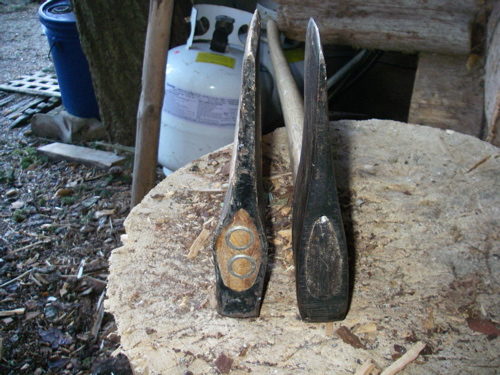Working with firewood on the homestead, I’ve found a need for specialized axes to some extent. I’ve spoken before of the uses of a so-called “boy’s ax.” I also use and maintain a splitting ax, for chopping firewood and kindling, and a felling or limbing ax.
A felling or limbing ax should be very sharp, for cutting wood fiber. The physics of wood splitting actually calls for the round to be forced apart more than cut, thus it requires a wedge-shaped blade. For the former, I prefer a thinner blade; for the latter, a broader blade.

Two “identical” axes, two different jobs. My splitting ax (l) and limbing/felling ax (r). (Photo: Mark Zeiger.)
Specialized axes are hard to come by anymore. That’s why I find mine among one kind of ax. Even with modern manufacturing processes, one can find variation among a single set of products. By sorting through the selection of felling axes at a local hardware store, I found two axes of the same make, each with a head that suited the needs of my two separate purposes.
The differences may appear subtle to the average observer, but I find them significant. Even though the upper blade of the felling ax appears more robust than the same portion of the splitting ax, it tapers down to a very thin wedge, perfect for sharpening to a proper cutting blade. So thin, in fact, that it’s often damaged on the job. When that happens, I can fix it.
Unfortunately, variation in manufacturing can cause problems as well. Note that the part of the head surrounding the handle on the splitting ax (left in the photo above) is very thin. It would have been better if this part of the tool had been as robust as its limbing counterpart, as splitting requires the tool to absorb a lot of force. This thin metal eventually broke on this ax. I continue to use it; I simply filed the edge of the break smooth so it doesn’t catch on the wood round. It continues to serve its purpose adequately, although a new splitting ax (chosen specifically for its sturdier construction around the handle) waits in the wings to take over when the first tool eventually fails.

I enjoy your posts and read your blog daily. You make a good point about the difference between splitting and cutting. But I usually use a splitting maul for splitting all but kindling as it has even better geometry for the task. Keep living the dream and sharing it with us through your blog!
Hi Brian,
I use a splitting maul, too, but only when necessary, usually to quarter a round. It is often too much tool for the job. I’ll use it to power the wood down into smaller chunks, then switch to the splitting ax as soon as I can. Since every ax that falls must first be lifted, I try to lift as little as possible. Judicious use can make a big difference to my 51-year old body after a few hours of splitting.
I really appreciate your faithful reading!
Mark